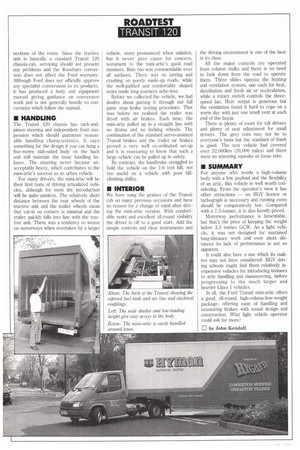ROADTEST TRANSIT 120
Page 68

If you've noticed an error in this article please click here to report it so we can fix it.
sections of the route. Since the tractive unit is basically a standard Transit 120 chassis-cab, servicing should not present any problems and the Rosebury conversion does not affect the Ford warranty. Although Ford does not officially approve any specialist conversions to its products, it has produced a body and equipment manual giving guidance on conversion work and is not generally hostile to conversions which follow the manual.
The Transit 120 chassis has rack-andpinion steering and independent front suspension which should guarantee reasonable handling characteristics. It says something for the design if you can hang a five-metre slab-sided body on the back and still maintain the basic handling balance. The steering never became unacceptably heavy, which contributes to the mini-artic's success as an urban vehicle.
For many drivers, the mini-artic will be their first taste of driving articulated vehicles, although for most the introduction will be quite painless. The relatively short distance between the rear wheels of the tractive unit and the trailer wheels mean that cut-in on corners is minimal and the trailer quickly falls into line with the tractive unit. There was a tendency to weave on motorways when overtaken by a larger vehicle, more pronounced when unladen, but it never gave cause for concern, testament to the mini-attic's good road manners. Ride too was commendable over all surfaces. There was no jarring and crashing on poorly made-up roads, while the well-padded and comfortably shaped seats made long journeys ache-free.
Before we collected the vehicle, we had doubts about putting it through our full panic stop brake testing procedure. That was before we realised the trailer was fitted with air brakes. Each time, the mini-attic pulled up in a straight line with no drama and no locking wheels. The combination of the standard servo-assisted Transit brakes and the trailer air brakes proved a very well co-ordinated set-up and it is reassuring to know that such a large vehicle can be pulled up in safety.
By contrast, the handbrake struggled to hold the vehicle on the 1:6 test hill, not too useful on a vehicle with poor hillclimbing ability.
We have sung the praises of the Transit cab on many previous occasions and have no reason for a change of mind after driving the mini-attic version. With comfortable seats and excellent all-round visibility the driver is off to a good start. Add the simple controls and clear instruments and the driving environment is one of the best in its class.
All the major controls are operated from column stalks and there is no need to look down from the road to operate them. Three slides operate the heating and ventilation system, one each for heat, distribution and fresh air or recirculation, while a rotary switch controls the threespeed fan. Heat output is generous but the ventilation found it hard to cope on a warm day with just one small vent at each end of the fascia.
There is plenty of room for tall drivers and plenty of seat adjustment for small drivers. The grey trim may not be to everyone's taste but the standard of finish is good. The test vehicle had covered over 32,000km (20,000 miles) and there were no annoying squeaks or loose trim.
For anyone who needs a high-volume body with a low payload and the flexibility of an artic, this vehicle is well worth considering. From the operator's view it has other attractions — no HGV licence or tachograph is necessary and running costs should be comparatively low. Compared with a 7.5-tonner, it is also keenly priced.
Motorway performance is lamentable, but that's the price of keeping the weight below 3.5 tonnes GCW. As a light vehicle, it was not designed for sustained long-distance work and over short distances its lack of performance is not so apparent.
It could also have a use which its makers may not have considered. HGV driving schools might find them relatively inexpensive vehicles for introducing trainees to attic handling and manoeuvring, before progressing to the much larger and heavier Class 1 vehicles.
In all, the Ford Transit mini-attic offers a good, all-round, high-volume/low-weight package, offering ease of handling and reassuring brakes with sound design and construction. What light vehicle operator could ask for more?
























































































































